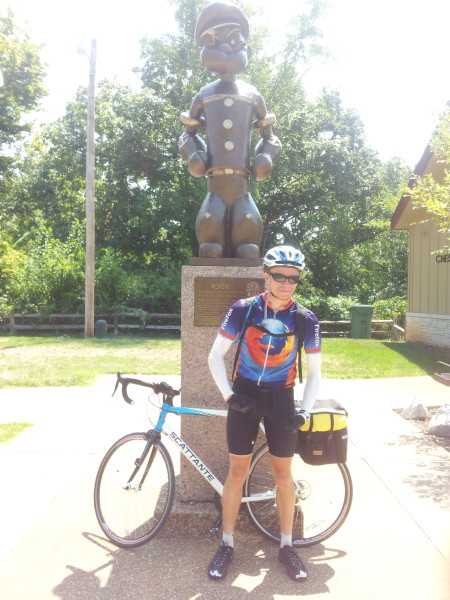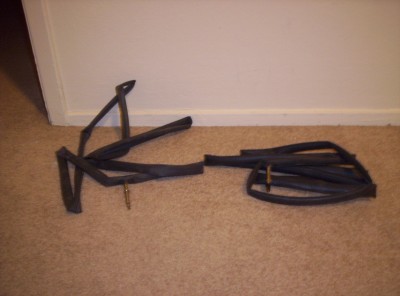(Hmm, seems I forgot August 31 was a day when scheduling these posts. 🙂 Subsequent posts will return to the one-a-day schedule.)
This is part eight of a series of posts discussing various aspects of a bike trip I did across the United States in 2012. Part one discussed the start of the trip and choosing a route. Part two discussed my daily routine and nightly shelter. Part three discussed general mileage, elevation encountered, and state-by-state scenery. Part four discussed mileage extremes and water. Part five discussed food. Part six discussed elevation extremes, particularly crossing the Continental Divide at Monarch Pass. Part seven discussed how I used down time and how I kept electronics charged. This post discusses mechanical issues and other surprises.
Mechanical problems
Tires and tubes
I replaced five bike inner tubes over the entire trip, and I replaced one tire about 750mi in after a catastrophic flat. After I returned I talked to someone who’d done a different cross-country route who’d had closer to a dozen flats. I’d have expected closer to a dozen flats than five for the trip, and no catastrophic flat (although I wouldn’t have been surprised to wear out a tire). As I carried two spare tubs and one spare tire, none of these mishaps presented any real issue. (Although after the catastrophic flat, I did just barely make it into the bike shop in the next town for a new backup tire and spare tube, before it closed for the day.)
Spokes
I anticipated possibly having to deal with broken spokes at some point or another, so I carried a round of replacements: one front, one back. Properly truing spokes is a black art, but I could probably fake it til I made it to a bike shop. The first time I broke a spoke, I heard a metallic snap but didn’t recognize it as a broken spoke. I only learned about it a couple hours later when the bike shop in Pueblo asked if I wanted it fixed. (Good timing on my part!)
The second broken spoke happened about twenty-five miles from the end of the trip — and it was actually two rear spokes. I didn’t have that many replacements, and I also, er, discovered I didn’t have the tools to remove the rear cassette to replace even one of them. (*whistles innocently* There aren’t many road-ready tools for doing this, actually, as cassette removal on the go is a very uncommon thing to have to do. These suggestions are about what I’m aware of now, but with no big trips planned, I’m not in a huge rush to pick one.) Beyond that, tho, I’d been told at a shop in Kansas that I really needed a new rear wheel. (They didn’t have any, but they said their jury-rigged fix might last til the end of the trip.) So ideally I didn’t want to install new spokes for only twenty-five miles. I removed the broken spokes and gingerly biked to a bike shop in Williamsburg, where I asked about just finishing the trip without them. The bike shop thought it could work if no more spokes broke, handed me a business card with phone number just in case, and advised me to avoid bumps and potholes. 🙂 This was a slightly frazzled way to end the trip, a couple hours later than expected, but it worked out.
Miscellaneous surprises
Traveling light
I knew, entering the trip, that I would be traveling very light. I would be (heh) on a non-touring bike; my seatpost rack limited me to 25 pounds in panniers; and I wouldn’t carry much on my back except water, repair tools, and sundries. I could do this because I’m comfortable traveling light as a backpacker. Doubtless many cyclists are backpackers, but I expected to be at the lighter end of the crowd. I did not expect to be the lightest. Every other long-distance cyclist I saw was on an apparently heavier bike with both front and rear panniers. I expected to see a cyclist or two touring with rear panniers (possibly even less in more-populated areas). I saw none. I don’t know how to explain this.

Locking up the bike
In normal life I carry a bike U-lock with me everywhere I go, locking up my bike whenever I have to leave it. I did the same on this trip, expecting I’d often leave it unattended while in stores and the like. In practice I did this, but as my route traveled through mostly lightly-populated areas, I only used it once, during a ninety-minute stop at a library in Kansas. (I didn’t lock it while in campgrounds, and in hotels I kept it with me in my room.) I’ve read stories of others biking across the country who’ve had bikes stolen, so it is a danger. Yet given what I saw and experienced, I’d consider leaving it behind were I to do this ride again.
Staying off-net
I despise phones in general and cell phones in particular. But for this trip, it seemed important to have one to be able to call ahead to arrange lodging as I traveled. So I set up a one-month prepaid plan with T-Mobile, to renew at the end of the month. This was actually a huge mistake, as I quickly learned that T-Mobile’s coverage outside metro areas is very sparse. (Data especially, but even call service was often light to non-existent.) In the west I was told by various people that Verizon or AT&T would work well in different places, and in the east apparently both worked equally well. It happens that T-Mobile’s being primarily an urban network is common knowledge to anyone in Silicon Valley with a cell phone. But that doesn’t include me, so I got to learn something. 🙂
As my data plan frequently didn’t work, or worked poorly, I used numerous apps with little data access. I was surprised how poorly many apps worked. Navigating through screens that downloaded data often didn’t cache that data: going forward and backward might require reloading just-viewed data. Goodreads was the biggest offender in this regard. Mobile developers: offline performance matters! Don’t sell it short just because you live in a San Francisco world of ubiquitous, high-quality, high-speed data. Vast swaths of the country are entirely unlike San Francisco in this regard.
Next time, health.
